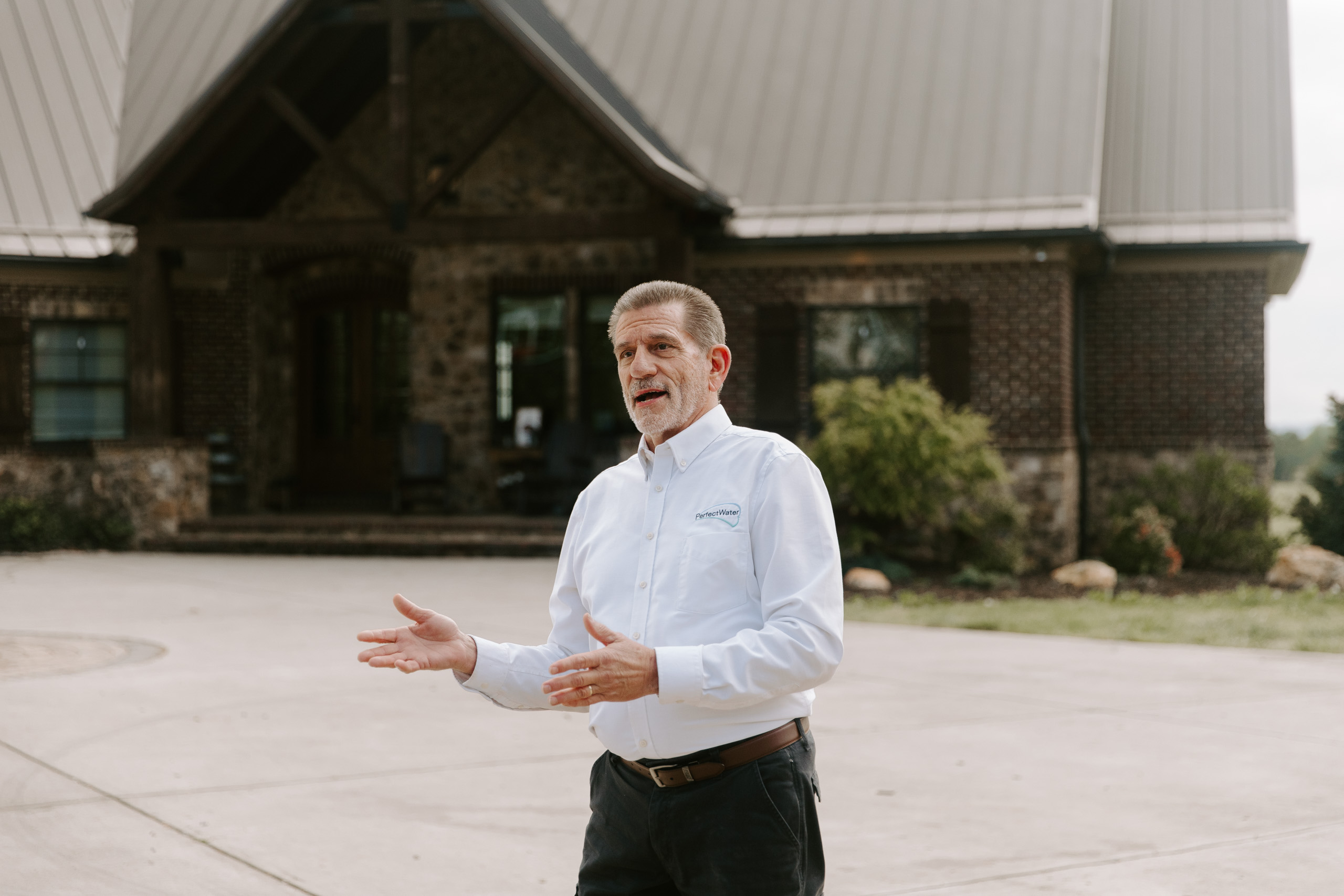From the Archives: Rainwater Reliance 2015

Franklin, TN
Aaron and Rebecca Howald of Franklin, Tenn., are busy professionals — she an attorney and he an executive for a national building products company. Their home site outside of Nashville might not have been buildable were it not for rainwater harvesting — it is distant from municipal water supplies, and wells in the area can be problematic.
The picturesque site does receive an average of 51 in. of annual rainfall. Figuring out how to capture and use that rain became a project of Knoxville, Tenn.-based [PerfectWater]. The Howalds decided to go all-in on rainwater harvesting and opted to make their new home 100% rainwater dependent. After more than a year of residence (with record-low rainfall) the decision has proven to be the right one.
Chemical-Free Treatment
Fundamental to the rainwater catchment system is the home’s 3,000-sq-ft asphalt-shingle roof. The Howalds’ anticipated annual consumption of 43,200 gal was not a high risk in that for each 1,000 sq ft of roof, 620 gal of water can be captured from each inch of rainfall. Their estimated annual harvesting potential is more than 71,000 gal. Moreover, capturing and using the rainwater on site meets current storm water control provisions, a fact that greatly reduced permitting and mitigation costs.
[PerfectWater] installed three 1,700-gal Norwesco polyethylene below ground cisterns for a total of 5,100 gal of storage. Unaffected by soil acids, these cisterns do not rust or corrode. Based on the Howalds’ average monthly water usage, they have approximately six weeks of reserve capacity in the event of an extended drought. A cistern, however, is just a container, and does not maintain clear, odor- and slime-free water on its own. The [PerfectWater] system, out of respect for the high quality of the water that lands on the Howalds’ roof, eschewed chemical additives in the tank. Instead, it designed a system that continuously maintains a natural biofilm inside the cistern. This biofilm, if undisturbed by turbulence, guarantees continuity of the rainfall’s original chemical-free water quality.
[PerfectWater] opted for German-designed Wisy components to protect water inside the cistern. These devices function with little maintenance and low power usage year after year. The Wisy Vortex prefilter mounted between the roof and tank is a major component. With no moving parts nor electrical power needed, this gravity-fed device diverts the first flush of contaminants (if any) from the roof to an overflow outlet. Then centrifugal force takes over and releases an oxygenated and filtered flow (280 µ) to the cisterns.
Other Wisy components inline between the Vortex filter and consumption are a stainless steel calming inlet, a capacity regulator, an overflow device and a floating filter intake. In the Howalds’ system, rainwater for potable use (already free of chemicals and minerals) first passes through a sediment filter and a carbon filter, and then is disinfected with ultraviolet (UV) light before traveling to faucets throughout the home.
The resultant water is naturally soft and clear, leading to benefits such as healthy skin and hair, improved flavor of brewed beverages and better laundry quality. And as Aaron, a home brew aficionado points out, “Rainwater makes great beer.”
Regulating Rainwater
What little treatment naturally pure rainwater requires is entirely dependent on its use. In many jurisdictions, rainwater intended for drip irrigation, toilet flushing or laundry does not need treatment. Potable use, however, is another matter. [PerfectWater] prefers to disinfect rainwater for potable use with UV light because, unlike chlorine, it is effective against both Cryptosporidium and Giardia.
Since launching three years ago, [PerfectWater] has been an evangelist for rainwater harvesting as an affordable response to certain storm water control problems. In hilly Tennessee, consuming rainwater on site versus releasing it into watersheds can sometimes be the difference between receiving a new construction development permit or not. Large commercial developments across the country often need to mitigate the runoff from many square feet of hardscape. Capturing, treating and reusing that runoff converts a liability into a measurable benefit.
Codes to permit use of rainwater inside dwellings and workspaces continue to vary nationally, but much work has been done to encourage uniform adoption of harvested rainwater. This is most evident in a publication by the International Association of Plumbing and Mechanical Officials, the Green Plumbing and Mechanical Code Supplement 2012 to the Uniform Plumbing Code, completed in collaboration with the American Rainwater Catchment Assn. and the American Society of Plumbing Engineers. In Georgia and Texas, codes and incentives exist to encourage the use of rainwater for irrigation, toilet flushing, laundry and potable use. In Nashville, toilets in the Music City Convention Center are flushed with harvested rainwater. In Cincinnati, until recently, a model use of rainwater, though constructed, was not operational, as codes to accommodate use had yet to be adopted.
Rainwater harvesting, now far beyond the rain barrel, is a growing niche business. How fast it will expand is unknown. That it will expand in a time of water shortage and infrastructure interruption is certain. For those in the water treatment business, it is a trend worth watching.
Footnotes
This article was originally published in the Water Quality Products (WQP) Magazine in February of 2015.
See the original post here: https://www.wqpmag.com/rainwater-reliance
Download the pdf version of this article here: Rainwater Reliance
Ready to Take Control of Your Water Supply?
Don’t wait for water shortages or unreliable sources to disrupt your life. With our Rainwater Harvesting systems, you can enjoy a sustainable, reliable, and completely self-sufficient water solution tailored to your home’s needs.

